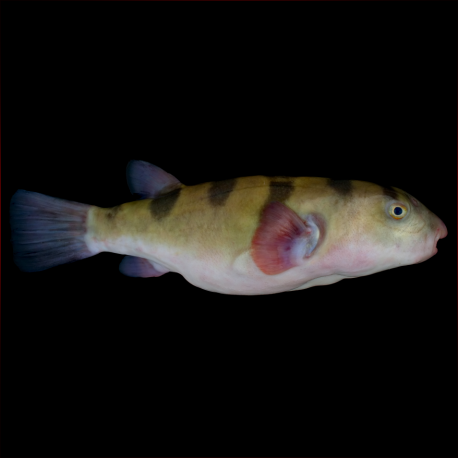More info
Datasheet
| Minimum Tank Size | 650 litres / 171.71 US gallons |
| Maximum Size | 29.0cm / 11.42inches |
| Temperature | 20°C / 68.00°F - 26°C / 78.80°F |
| Hardness | 10.03dgH / 179ppm - 25.04dgH / 447ppm |
| pH | 7.0-9.0 |
General Description
The Banded Puffer, scientifically known as Colomesus Psittacus, is a species classified under the Tetraodontiformes order. It is commonly referred to as the "parrot puffer" in the ornamental trade. This species can be distinguished from its congeners by features such as its larger adult size, possession of 17-19 pectoral-fin rays, and 6 transverse dark bands dorsally on the body. Banded Puffers are predominantly found in brackish, coastal habitats and are known for their ability to inflate their bodies when stressed, a characteristic common among puffers.
Aquarium Setup
For optimal care of Banded Puffers, a tank setup of at least 650 litres is recommended. The aquarium should be well-decorated, resembling the natural mangrove habitats. Keeping the water clean is crucial, as these puffers are intolerant of organic waste. Moderate levels of dissolved oxygen and water movement are essential, achievable through powerheads, pumps, and a linear flow pump. Regular 30-50% weekly water changes are necessary, and maintaining a specific gravity of 1.010 or higher by adding marine salt is advised.
Behaviour
In the wild, juveniles of the Banded Puffer are observed to form loose aggregations. However, in aquarium settings, this species tends to display aggressive behavior, especially in smaller tanks. It is recommended to house them in larger systems to minimize aggression towards tankmates.
Feeding and Diet
The Banded Puffer is chiefly carnivorous, preferring molluscs and crustaceans like barnacles and Brachyuran crabs in the wild. As they mature, they transition to more mobile prey. In captivity, offering unshelled crab legs, cockles, mussels, and prawns is essential. Banded Puffers lack true teeth but possess modified jawbones that serve as tooth-like structures, requiring a diet that helps maintain the length of these structures.
Reproduction & Dimorphism
Details regarding the reproduction of Banded Puffers remain unrecorded, and sexual dimorphism in this species is unknown. Further research is needed to understand their reproductive habits and any distinguishing characteristics between males and females.
Habitat and Distribution
Banded Puffers primarily inhabit mangrove swamps, estuaries, and other saline environments. They are commonly found in tidal channels, shallow inshore lagoons, and the lower reaches of rivers. Their distribution ranges from Magdalena Department in Colombia to northeastern Brazil, including locations like Venezuela, the Guyanas, Trinidad and Tobago, and various Caribbean islands. Although they may venture into river basins, their main preference is brackish coastal habitats.

